
Water2Drink Blog
World Water Day 2015Sunday, March 22, 2015 - Posted by Water2Drink, in Water News, Water Safety
Water2Drink invites you to celebrate to World Water Day 2015! Today is an opportunity to increase water
education and awareness of global water concerns, and to take steps to ensure
your family, your community, and the worldwide population has access to safe,
clean drinking water. To celebrate #WorldWaterDay, please watch this short video
by #LoveWater2015. It is visually stimulating and full of important facts
regarding planet Earth’s fresh water supply.
Some powerful quotes from this video…
“78% of the Earth’s
surface is water, yet only .01% is fresh and drinkable.”
“We have polluted
almost 95% of all fresh water on the planet.”
“More people die every
year from waterborne illnesses than from war.”
Water2Drink.com is proud to be an exclusive Multipure International distributor. With almost
45 years of dedication to water filtration, #Multipure is a pioneer in offering
innovative filter technology that provides superior quality and performance. #Water2Drink offers and supports the entire
family of NSF-tested and certified drinking #water systems from Multipure. Each product comes with a Performance Data
Sheet, a Lifetime Warranty (on the stainless and plastic housings), a 1-Year Warranty
on all Accessories, and a 90-Day Satisfaction Guarantee.
As the #LoveWater2015 video says, “Just as water can change course, so can we.” |
 0 Comments 0 CommentsTweet |
How Exposed Are You?Friday, March 13, 2015 - Posted by Water2Drink, in Health, Water News
An interesting study came across the Water2Drink.com news desk
this week. It is the 2014 Silent Spring Institute’s “Scientists Identify
Highest Priority Toxic Chemicals to Target for Breast Cancer Prevention Study
Fact Sheet.” This fact sheet gives breast cancer prevention tips by “identifying
high-priority chemicals and evaluating tools to measure exposure” to suspected
carcinogens.
The measurement methods are called “exposure biomarkers.” They can be used to study cancer risk and
assist the public in reducing exposure to known or suspected toxins. Many chemicals, though, have never been
studied because there was no reliable way to measure exposure to carcinogens.
Scientists need to track exposures to toxins to determine where they come from
and to investigate if exposure reduction efforts make a difference.
The Silent Spring Institute study is easy to read and understand. The study “evaluated 102 common chemicals
that cause mammary tumors in laboratory studies of rodents.” Many of these chemicals are from gasoline and
the petroleum industries. More specifically, the study says “Drinking water can
contain mammary carcinogens, such as byproducts of disinfection or solvents
that are common well water contaminants.”
While the study provides implications for public health,
more importantly it contains a section that addresses how to reduce your
personal exposures (#SilentSpring Study, Page 5). And while this study focuses on #breastcancer,
the ways in which to reduce or eliminate the risks could apply to many #cancers.
There are many practical and easy steps, such as avoiding fuel and exhaust
(petroleum), using ventilation fans, and properly storing solvents and other
chemicals. The most significant suggestion is: “Use and maintain a solid carbon
block drinking water filter.”
The entire Multipure family of drinking water systems
feature a solid carbon block filter that is NSF-tested and certified to the
sub-micron level. A #Multipure Drinking
Water System does an amazing job of reducing chloramine, chlorine, disinfection by-products, and dozens of other contaminants, both naturally occurring
and man-made. |
 0 Comments 0 CommentsTweet |
Do You Know Your Neighbors?Friday, March 6, 2015 - Posted by Water2Drink, in Health, Water News, Water Safety
The March 5, 2015, issue of The Atlantic online magazine (theatlantic.com)
covers a consequential story about the Rice family outside of Asheville,
NC. Bob and Dot Rice bought a piece of
property in 1974, built a home there, raised children, and planned for the property
to be passed along to their two sons and their children. The home water source was a local spring a
few hundred yards behind the family cabin. According to the article, “after they moved in, the
Rices noticed the water coming out of the spring had a salty taste and smelled
musty.” They could smell a distinct #petroleum
smell coming from their well and spring, “especially when it rained. ‘I got
used to it,’ Terry Rice said. ‘We checked for bacteria. We didn’t check for
chemicals.’” In 1999, a family friend
discovered environmental contamination in the spring, along with barrels from a
long-closed factory that once bordered the property.
The contamination came from CTS Corporation, which operated a
factory plant that closed in 1986. The
company produced electronic components, and workers there used #TCE, a
colorless solvent with a sweet odor.
The article states, “Drinking or breathing high levels of TCE may cause
nervous system effects, liver and lung damage, abnormal heartbeat, coma, and
possibly death, according to the Agency for Toxic Substances and Disease Registry website. The EPA investigation found that CTS employees
were disposing of TCE and other chemicals by pouring them down the drains and
letting the chemicals leach into the ground.” A year after closing the factory, the company
sold the property to developers who had the soil at the site tested, but never had
the groundwater sampled or tested. Adding
insult to injury, the EPA “had a chance to clean up the site years ago but
didn’t. A memo from 1991 shows that federal regulators knew pollution from the
former factory threatened the surrounding community’s water and air. But the
agency failed to do more testing or even warn residents of potential dangers.”
This type of contamination can be an environmental nightmare. A wide range of chemicals can contaminate our
water, land, or air, which impacts our environment but also our health. Some pollutants resist breakdown and can
accumulate in the #foodchain, being absorbed by fish or wildlife, and then
eaten by residents. Contamination can
also impact coastal areas, waterways, surface water sources, and groundwater. It can be years or decades before the
contamination is identified, and even longer for the sites to be cleaned and
the water source becomes healthy again, if ever.
To combat environmental contamination, water consumers and
home buyers should educate themselves on the surrounding areas. What businesses
or industries are or were nearby? Were there #chemicals used in that industry? Has
there been environmental testing in the area? Even if your water source is
municipal (provided by your city or county), there are many opportunities for
water contamination to occur between a water treatment plant and your
home.
We at Water2Drink.com believe you have the power to protect
yourself and your family by using a water filtration device such as a Multipure
Drinking Water System. The family of #Multipure Drinking Water Systems are NSF-tested
and certified to reduce TCE and dozens of other chemical and organic contaminants,
including arsenic, metals and cysts. Each Multipure filter Owner’s Manual comes
with a Performance Data Sheet that outlines exactly what contaminants the
filters are certified to reduce, and to what degree. Most contaminants are reduced
more than 99 percent! |
 0 Comments 0 CommentsTweet |
Your Water CycleSaturday, February 28, 2015 - Posted by Water2Drink, in Water News, Water Safety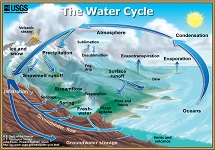
When you think about it, all water on the planet is
recycled. The water cycle that we
learned about in elementary school (evaporation; condensation; precipitation;
collection) shows that the Earth’s water is always in movement on, above, and
below Earth’s surface. Of the world’s
total water supply (about 332.5 million cubic miles), over 96% is saline, or
salt water. Of the total freshwater available
to us, over 68% is unavailable, frozen into ice and glaciers. Within the #watercycle, the fresh water
sources we use (surface and ground waters) are the only waters available to
sustain life. So how do we treat this water? Once we use water, it is
gathered by sewer or septic field, treated, and released back into the environment. Most of us know generally that water
treatment plants collect surface or ground #water, treat it to remove
contaminants, and then distribute it to our homes, fire hydrants, and water
fountains. Would you like to know a
little more about that process?
The Environmental Protection Agency (EPA) has created a
virtual tour of a water treatment plant so consumers can see step by step what
actions are taken in the treatment and delivery of drinking water. The #EPA video explains the difference
between surface and ground water, points out potential sources of #contamination,
and describes the disinfection process.
It is yet another source of information for water consumers as they
decide whether this process is enough to protect your health, or if they would
like to use a final barrier solution, such as a home-installed #Multipure
Drinking Water System. |
 0 Comments 0 CommentsTweet |
Does Your Local School Serve Toxic Water?Thursday, February 19, 2015 - Posted by Water2Drink, in Health, Water News, Products, Water Safety
California has myriad water woes, and here’s another one to
consider. Seven years ago, the local
NBC4 I-Team investigated Los Angeles area schools that had children drinking
from potentially unsafe water fountains.
The schools had old fountains and pipes made with lead that leached into
the drinking water. Today, thousands of
schoolchildren in L.A. are still drinking from these fountains. The NBC4 story states the Los Angeles Unified School District
(#LAUSD) would solve the problem by having the water lines to each fountain
flushed daily, running the water for a minimum of 30 seconds at the beginning
of each school day. The schools were to
keep logs for proof that the lines were flushed. But a 2013 audit report says one #school was
found to have falsified the logs, and an additional six schools claimed they
had followed the policy but in fact hadn’t.
Lead leaching from older pipes and fixtures is a chronic
problem in older buildings like schools, and this problem can occur in any
school district in the country. The problem is exacerbated when communities use
chloramine to disinfect their water, which accelerates #lead leaching. Chloramine is a disinfectant that is
formed by mixing chlorine with ammonia.
It is a less effective disinfectant than chlorine, but is longer lasting
and stays in the water system as it is transported to the point of use.
The solution? Carry fresh, filtered water from home, using a
Multipure Drinking Water System from Water2Drink. The #Multipure family of drinking water
systems are all tested and certified to reduce #chloramine, along with dozens
of other contaminants, metals, PCBs, and cysts.
Using a Multipure system for your drinking water costs just $.09 cents a
gallon, and provides assurance that you are using a superior water filter in
removing or reducing the highest number of contaminants. Water2Drink.com is
happy to answer your questions about choosing the best #waterfilter for your
family’s needs. |
 0 Comments 0 CommentsTweet |
What Are Your Drinking Water Standards?Friday, February 13, 2015 - Posted by Water2Drink, in Health, Water News, Water Safety
If your community water system violates drinking water
standards, do you trust them when they say “there is nothing you need to do?” Recently, the town of Wrightsville Beach, NC, experienced a
violation of the drinking water standard for #trihalomethanes. While the public notice indicates this is not
an emergency, it goes on to list the possible health risks associated with the
liver, kidneys, and central nervous system, including #cancer.
The town is working with the NC Department of Environment
and Natural Resources (NCDENR) to bring the contaminant concentration down and
into compliance, and that they “anticipate improvements within three months.” The
notice also says the public doesn’t need to boil water or take other corrective
actions. But during that three-month
period, and for potentially longer, the public is still exposed to
trihalomethanes in their drinking water.
If this happened to your water supply, are you willing to risk your
health for three months?
The only way to ensure your health and the safety of your
drinking water is to be proactive. Using
a Multipure Drinking Water System allows you to be in control of the quality of
your water source. The Multipure family
of filtration products are NSF-certified to reduce trihalomethanes, the
offending contaminant, along with dozens of other #contaminants, cysts, and
heavy metals.
Water2Drink believes the consumer should know exactly what
contaminants are reduced by using a #Multipure product. On our website, Water2Drink.com, we have
provided links on each product page to the description, features,
documentation, specifications, and “What’s in the Box.” Simply click on the Products link on our
homepage, then click the drinking water system you are researching. You will find the Performance Data Sheet
listed under the “Documentation” tab.
You can’t always trust the water source, but you can trust your
Multipure Drinking Water System.
|
 0 Comments 0 CommentsTweet |
The True Cost of WaterFriday, February 6, 2015 - Posted by Water2Drink, in Water News
If you are purchasing bottled water for convenience, have
you considered the true cost of that choice? Bottled water companies spend millions in advertising to
convince you that their product is the purest and most healthful available. But bottled water is not well regulated or
safer than tap water. More than 25% of
bottled water comes from municipal (public) supplies, and bottlers are not
required to list the water source on the label. This means your bottled water
could have come from a well located near a hazardous waste site. It also may
contain chemicals that leach from the plastic bottle, in addition to other
unknown contaminants present in the water source.
Buying bottled water means you often pay much more per
gallon than you pay for gasoline. A
recent search of prices at Walmart revealed one popular brand of bottled water costs $3.73 per gallon. If buying in
bulk at a big box store such as Costco, you could pay $1.56 or more per
gallon. And buying for single use (i.e.,
from a hotel minibar or convenience store) can be more than $10 per
gallon. When you look at the actual cost
per gallon, the true cost of #bottledwater is exorbitant.
Also, the environmental cost of the massive consumption of
bottled water is extreme. Bottles can
take over 1,000 years to bio-degrade and, if incinerated, they produce toxic
fumes, states The Water Project’s website.
Water bottles provide limited recycling opportunities, because only
certain types can be recycled. Only one
out of five bottles are sent to the recycle bin, says The Water Project.
So what is the most practical solution? Carry and drink your own filtered tap
water. Purchasing and using a
high-quality, low maintenance water filtration system such a Multipure Drinking
Water System will provide you the freshest, most convenient water source
possible. Owning a #Multipure drinking
water system will give you delicious, clean water for only $.09 per
gallon. This is almost 48 times less
expensive than imported bottled water.
Having your own certified water filtration system allows you to be in
control of the water you ingest. It also
eliminates the environmental impact of both the manufacturing and disposal of
all those plastic bottles. |
 0 Comments 0 CommentsTweet |
Your Pet: Merely a Companion, or a Member of the Family?Saturday, January 31, 2015 - Posted by Water2Drink, in Health, Water Safety
For many of us, our pets are not just a companion to us. Pet owners often consider their pets to be an
actual family member. Whether
four-legged and #furry, or two-legged and feathery, we want to give our family pets
the very best lives we can. Pet industry expenditures have skyrocketed more than 200% in
the past 20 years. Pet owners spare no expense on nutritious food, high quality #veterinary care, holiday presents, and necessary pharmaceuticals or
surgeries. We devote ourselves to
ensuring our pets have a quality of life at least as high as our children or
other family members.
When providing for the health, safety and comfort of your
pet, have you considered the quality of water you are providing? Using water from the tap or from a garden
hose can expose your #pets to contaminants that pose a threat to their health. These can include arsenic, cysts, lead, PCBs,
and radon. Tap water may be treated in
your community, but your pet will ingest the chemicals used in the water
treatment process, such as chlorine and chloramine. Filling up their outdoor water bowl from the
garden hose poses an entirely new level of contamination, as garden hoses can
contain hazardous chemicals and metals such as parasites, lead, cadmium,
bromine, and bisphenol A. Also, keep in mind that unlike residential fixtures, #gardenhoses
and fittings are not regulated under the Safe Water Drinking Act. |
 1 Comments 1 CommentsTweet |
The Next Generation: Teaching Our Children About Water ResourcesWednesday, January 21, 2015 - Posted by Water2Drink, in Health
As adults, we are able to easily find information about water
resources, water efficiency and #conservation.
Why not set an example for our next generation, who will be directly impacted
by our choices today? Children are naturally curious about the world around them.
They are thirsty for knowledge, and they also exhibit compassion for issues
that affect them. Bringing water
efficiency and conservation to their attention at a young age can allow them to
learn and take ownership of this important resource. The Environmental Protection Agency has
created “Water Sense Kids,” an easily approachable learning tool. It provides simple examples and promotes
water conservation. It also has a link
specifically for educators, which provides program materials to be used
alongside the “Water Sense” information.
Water2Drink.com believes the key to a good life is having
great #health. We believe good healthy
habits begin in childhood, and drinking plenty of clean, delicious water is a
habit that can be easily created in children.
Once your #children are treated to healthful #water, they will most likely
choose Multipure-filtered water over other beverages. |
 0 Comments 0 CommentsTweet |
Finding What You Need to KnowWednesday, January 14, 2015 - Posted by Water2Drink, in Water News, Products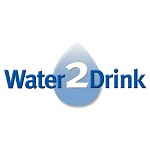
Recently, we received feedback from our customer, D.
Dixon, about our website: “I'm really liking your website. Full of great
information, especially the links to the EWG water quality data and the cross
reference to filters by chemicals treated.”
Today, Water2Drink would like to highlight some features of our website
that may help you with your water filtration purchase.
Our website, Water2Drink.com, is full of useful information
regarding the entire Multipure family of water filtration systems. We believe that this information is critical
for our customers to become better educated on how Multipure’s solid carbon
block filter is superior to other technologies on the market. We encourage our customers to explore our
website in depth to learn how and why the #Multipure products are so highly
effective at #contaminant reduction.
Thanks to our customer, D. Dixon, here are a few
suggestions on where to begin:
EWG U.S. Tap Water Quality Database. This link (under “Useful Links” on the bottom
of our home page) takes you to the Environmental Working Group’s National
Drinking Water Database. On this page,
you can enter your zip code and/or your water company’s name, and the Database
will provide the results of testing done by the water company. It will specifically list the contaminants
that exceed health guidelines in your own water supply. Knowing this
information, you can use our Detailed Product Information link (described
below) to pinpoint the #water filtration system that will best meet your needs.
Detailed product information. We provide a link to
every Multipure product’s Specification Sheet (describing benefits, features
and specifications), Performance Data Sheet (providing the list of contaminants
reduced), and Owner’s Manual (including Warranty, Installation, Operation and
Maintenance information). These links
are located under “Product Manuals” in our Resource Center, and are especially helpful
in determining which system will address your specific needs. They also provide advance information for
your plumber or installer, should they have any hardware, fittings, or installation
questions. The Multipure Challenge. This link is located in our Resource Center,
under the “How a Multipure Water Filter Works” tab. The Multipure Challenge is a cross reference
list of common, harmful contaminants and the filter technologies that address
them. Only Multipure’s solid carbon
block filtration system effectively reduces all contaminants, while not
eliminating the naturally occurring, healthful dissolved minerals. |
 0 Comments 0 CommentsTweet |
Raising Awareness of AsbestosMonday, January 5, 2015 - Posted by Water2Drink, in Health, Water Safety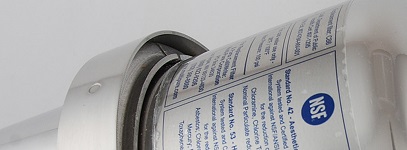
Most Americans know the dangers of asbestos, a naturally occurring
mineral. Asbestos was heavily used from the
1930’s to the 1970’s as insulation on water or steam pipes, and in floor, ceiling and
siding tiles, textured paint and soundproofing materials. Many people believe asbestos was banned from
use in the 1970’s, but a complete ban was decided against by the U.S. #Congress, allowing
numerous asbestos-containing products to remain on the market. Some of these include construction materials,
automotive products such as gaskets and brake pads, and asbestos clothing such
as gloves and welder’s blankets.
If you suspect your home contains asbestos, don’t
panic. Older homes often do contain it,
but if the material is in good condition and not deteriorating, the best
solution is to leave it alone. Material
that is crumbling, or if it has been scraped or sanded, is more likely to
create a health hazard. However, even if
your home does not contain #asbestos, it is possible that because asbestos is
still in our environment, you are at risk for exposure.
A recent blog post by Adam Lee, who writes for The #Mesothelioma
Center, describes how asbestos can be found in our tap water via its use in the
cement pipes of water distribution systems around the country. The U.S. Environmental Protection Agency
(EPA) screens for and regulates the levels of acceptable contaminant levels,
and in 1992 the EPA added asbestos to the list of #contaminants often found in
tap water.
Of course the only way to know you are not ingesting asbestos
is to filter your drinking water, using a high-quality filter that specifically
addresses asbestos as a contaminant. The
Multipure family of water filters are all tested and certified by NSF
International, the independent third party that is widely recognized around the
world for its expertise in testing and certifying consumer goods for health and
safety. All Multipure Drinking Water
Systems are NSF certified to reduce asbestos. |
 1 Comments 1 CommentsTweet |
Improving America's Drinking Water SystemsMonday, December 29, 2014 - Posted by Water2Drink, in Water News, Water Safety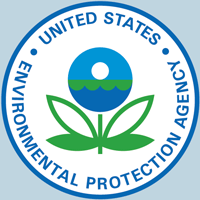
While many citizens may see the Environmental Protection
Agency (EPA) as a “watchdog” agency for American waterways, the EPA also researches
ways to improve our national drinking water systems. An EPA news release in September, 2014 announced the #EPA is
providing funding to create “Drinking Water Innovation Centers.” According to the release, “These centers will
help to develop innovative and practical solutions for challenges faced by
smaller drinking water systems, which make up the majority of public water
systems in the United States.”
Of the nation’s approximate 160,000 public water systems,
about 97% of them service fewer than 10,000 people each. These water systems
face many obstacles, such as limited funding, aging structures, and the cost of
complying with new regulations. The
newly funded centers will help bolster these systems’ capacities and
capabilities to provide #water throughout the country.
The recipients of the funding are the University of #Colorado
Boulder’s Design of Risk Reducing, Innovative Implementable Small System
Knowledge (DeRISK) Center, and the University of #Massachusetts Amherst’s Water
Innovation Network for Sustainable Small Systems (WINSSS) Center. “These organizations are leading the way in
developing cutting-edge technologies,” according to the EPA news release. |
 0 Comments 0 CommentsTweet |
Is It Safe to Drink the Water?Friday, December 19, 2014 - Posted by Water2Drink, in Health, Water News
If you are living in the United States, you probably have
never had to ask that question in any restaurant, private home, or business
setting. Most Americans believe that the
water pouring from their faucets is a reliable source of safe drinking water. Almost
no American has ever had to ask, is it safe to drink the water? Clean, safe public drinking water was not always so
available. Public water systems began to be established in the 1800’s, yet the
first standards for drinking water were not developed until 1914, and even then
the standards only applied to interstate common carriers such as trains, buses,
and ships. A comprehensive article by Professor
James Salzman and published by Slate.com states, “In historic terms, the
assumption of safe drinking water is a very recent development.” What we now
consider safe, uniform drinking water
standards weren’t actually put into place until the Clean Water Act of 1972,
and with the passage of the Safe Drinking Water Act (SDWA) of 1974.
However, while these measures certainly deserve recognition,
there are still significant challenges ahead for public drinking water delivery
systems. The Environmental Protection Agency has estimated $384 billion in
infrastructure needs ahead to replace aging water mains, which date back to the
1860’s. The SDWA is also faced with “emerging contaminants,” by-products of our
modern lifestyle. Newly recognized contaminants from medications, personal care
products, and components that act like hormones were unimaginable when our
water treatment systems were designed.
Even new contaminants introduced by hydraulic #fracking have not yet been
addressed. Therefore, these polluted fluids and #contaminants are not now being addressed
by municipal treatment plants.
These infrastructure changes will take incredible amounts of
effort, time and money. Don’t wait for
the public infrastructure to “catch up” to what is happening today. Get ahead
of these potential health hazards and filter your own water at the point of use. #Water2Drink recommends industry-leader Multipure
International as the high-quality, reasonable-cost manufacturer. As these newly emerging contaminants affect
our water supply, Multipure is constantly pursuing improvements to their solid
carbon block filter to address these concerns. Water2Drink.com is here to help
you decide which filter will provide the protection you need. |
 0 Comments 0 CommentsTweet |
Are You Affected by Storm Events?Friday, December 12, 2014 - Posted by Water2Drink, in Water News
This week, the U.S. Pacific coast has been dealing with
severe storms in California, Oregon and Washington, while the East Coast has been
hammered by winter storm #Damon. While you may have been unaffected by these particular
storms, across the globe we see evidence of climate change that may directly impact
you in the future.
According to the article “Thirsty
for Answers: Preparing for the Water-related Impacts of Climate Change in
American Cities” on the Natural Resources Defense Council website, cities
across our country “face significant vulnerabilities due to climate change,
ranging from water shortages to more intense storms and floods to sea level
rise.” The NRDC believes that action at
the local level is going to be the most effective way to reduce or prevent
these effects. The NRDC compiled
research on 12 U.S. cities, and has prepared a sideshow to offer a glimpse of
some of the threats. Nearly all of the
cities show “water supply challenges” likely to occur as a result of
#climatechange.
You can help mitigate storm-related water contamination
issues by using a high quality point-of-use water filtration system in your
home and office. Water2Drink.com sells only Multipure’s Drinking Water Systems
that feature a solid carbon block technology with exceptional performance. The
Multipure family of products is NSF certified to reduce a wide array of
contaminants, including disinfection byproducts and gasoline additives. These contaminants can get into water sources
through storm events, pollution or erosion. |
 0 Comments 0 CommentsTweet |
How Does Your Water Taste?Friday, December 5, 2014 - Posted by Water2Drink, in Water News, Water Safety
Recently, residents of Abilene, #Texas, have noticed an
unusual taste and/or odor in their drinking water. KTXS12 News reports that, in the city’s news
release, the City of Abilene says, “the water is safe to drink.” If you noticed an unusual taste or odor in your
local drinking water, would you be reassured by that statement?
According to the news release from the City of #Abilene, the
Water Department staff is experimenting with various solutions to solve the
problem, including using “additional treatment chemicals to address the issue.” While we all have heard that Everything Is Bigger In Texas, is putting
more chemicals into the water supply a good thing for consumer health?
The Environmental Protection Agency (EPA) sets water quality
standards for consumer protection. These
standards are for a minimum of public safety, and as a consumer you need
to ask yourself if minimum EPA standards are good enough for you and your
family. It should also be noted that the
EPA does not enforce #waterquality standards for taste or odor compounds that
do not pose a health risk to the public.
The safest, easiest solution is to use a high quality
point-of-use Multipure Drinking Water System.
Water2Drink.com sells only #Multipure Drinking Water Systems. We have found that Multipure’s unique solid carbon
block filter provides a wide range of #contaminant reduction that affects both
the healthfulness and the aesthetic properties (taste and odor) of water. Multipure is one of the few companies whose
products are tested and certified by NSF International to reduce such a wide
array of drinking water contaminants.
|
 0 Comments 0 CommentsTweet |
Pros and Cons of Reverse Osmosis Treated WaterSunday, November 30, 2014 - Posted by Water2Drink, in Products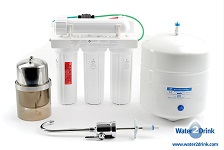
We here at Water2Drink.com want to be sure you have the
information you need to make an informed choice about your water filtration system. We want to talk to you, our customer, to gain
insights into your water filtration needs, such as how many people will be
using the filter, what type of water resource serves your area, and any
potential health hazards in your water supply that must be addressed. We strive to help you obtain the most
efficient, cost-effective Multipure Water Filtration System to meet your personal needs.
We often receive inquiries about using a reverse osmosis
(RO) water filtration system. Many
people are under the mistaken belief that, if removing dissolved contaminants
is healthful, then removing ALL dissolved minerals will be even more
healthful. This is simply not the
case. While there are times when an RO
system is exactly what is needed, most often an #RO system will remove the good
with the bad, according to University of Wisconsin health family medicine
physician Jacqueline Gerhart.
If you were to compare the pros and cons of an RO system,
you would find the list to be somewhat unbalanced. Very briefly, here is a short list of pros
and cons that we came up with to help you understand that sometimes less is
more.
The pros of having a Multipure 5-step Reverse Osmosis
drinking water system include:
However, there are many cons that must be considered as
well. For example, an RO filter:
While certain circumstances dictate the use of a Multipure
AquaRO drinking water system, most often your health goals can be better met by
another Multipure product family.
Contact #Water2Drink today to ask questions and get answers to help you
decide what is right for you. |
 0 Comments 0 CommentsTweet |
Is Your Filtered Water Cloudy?Friday, November 21, 2014 - Posted by Water2Drink, in Health, Water News, Products, Water Safety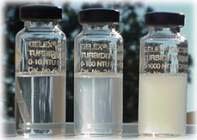
It’s that time of year again, when the snow is blowing, the
wind is howling, and your water is… cloudy? Probably the single most asked question we get in the wintertime
from our customers is, “Why is my filtered water cloudy?” Water can be cloudy for two reasons, one that
is benign and one that can be very bad.
The benign answer is:
it’s just air. If you are using a
high quality point-of-use water filter, such as a Multipure Drinking Water
System, you may be surprised to see cloudy or milky-looking water coming from your
filter. This most often occurs when the
water is cold (coming from cold ground water or being transported underground
through cold pipes). One of the
properties of water is its ability to dissolve gasses, including #air. Cold water is denser than warm water, and
therefore it is capable of holding more dissolved gasses. The cloudiness or milkiness is simply
dissolved air. You can test this by
filtering a glass of water and letting it set on the counter for a moment or
two. The cloudiness (air) will dissipate upwards from the bottom of the glass,
leaving a glass of clear filtered water.
Why is this not considered turbidity? Turbidity is the measure of relative clarity
of a liquid, or of how much material may be suspended in water and how that
material decreases the passage of light through the water. Turbidity refers to how clear water is, and
indicates the presence of total suspended solids. When solids are present in water, this
indicates the water is not clear of particulate matter, and these solids may
also be contaminants of great health concern. An article on Waterontheweb.org states, “turbidity
adds real costs to the treatment of surface water supplies used for drinking
water since the #turbidity must be virtually eliminated for effective
disinfection (usually by chlorine in a variety of forms) to occur. Particulates may also provide attachment
sites for heavy metals such as cadmium, mercury and lead, and many toxic
organic contaminants such as PCBs, PAHs and many pesticides.”
Of course, you must use a quality water filtration system such
as a #Multipure filter to remove particulates and contaminants. But just how does this filtration work? For contaminants having a physical size, the solid
carbon block filter provides mechanical filtration on a submicron level to
remove particulates and bad tastes. It
also employs electrokinetic adsorption to attract and control charged particles. Almost any carbon filter can reduce chlorine
and address taste and odor problems. The
Multipure solid carbon block technology goes well beyond aesthetic improvements
to remove the broadest array of #contaminants, including turbidity. Each product in the Multipure family is
provided with a Performance Data Sheet that details NSF’s product certification
data and contaminant reduction test results.
|
 5 Comments 5 CommentsTweet |
How to Save Money on Your Multipure PurchasesSaturday, November 15, 2014 - Posted by Water2Drink
Have you wondered why Multipure product prices are not
discounted, and whether it’s possible to receive any type of discount on
Multipure products? Multipure produces superior water filtration products, and
the performance of these products is tested and certified by NSF, the
organization that sets the industry standards for objectively comparing
drinking water systems. As such, the
prices set by the manufacturer reflect their extensive investment in research
and development, product design, performance testing, and system warranties and
guarantees. Therefore, Multipure believes
its prices are fair and reflect the superior quality being offered to you, the
customer; therefore, neither Multipure nor their distributors #discount the purchase
price of these products.
Nonetheless, Water2Drink.com can save you money on
your next Multipure purchase. If you are looking to buy a water filtration
system, select the popular Filtermania option.
This offer (available on the Aquadome, Aquaversa and Aquaperform
systems) bundles the cost of 10 years of replacement filters into the initial
purchase price, and you receive the water filter system for free. Your initial shipment includes the free
water filtration unit and one filter. Shortly
thereafter, you receive coupons for the remaining nine filters. A week or two
before you need to replace the filter, simply mail in one of the coupons to
Multipure and a new replacement filter cartridge will be shipped directly to
you. The Filtermania offer locks in the
cost of replacement filters for 10 years at today’s prices, and Multipure only charges
you the current shipping fee of the filter. This attractive offer is expected
to be eliminated in 2015, so now is the time to get your free water filtration
system!
For new system purchases, Multipure also allows
distributors to offer a purchase promotion to their customers. Multipure
purchase promotions change every quarter, and they can be combined with the
#Filtermania promotion. With the purchase of a new drinking water system, in
the past we have offered a free Aquashower Filter, a discount on a specific
product, or a promotional product such as an Emergency Filter. This
purchase promotion is offered exclusively through Water2Drink as a Multipure
distributor. If you already own a #Multipure system, another
way to save is by joining the Automatic Filter Replacement Plan. By
signing up for automatic annual filter replacement, you can take 15% off the
retail price of a Multipure CB6, CB6AD or CB11As replacement filter cartridge, both
now and on future purchases. Multipure will ship to you a fresh new
replacement filter cartridge every 12 months and charge your credit card for
the discounted purchase price (plus shipping and sales tax, where applicable). These cost saving opportunities are always
showcased on the Water2Drink.com website. Simply click on “Current Promotions” under the Buy Now tab
to all current offers. You can select the promotion during online checkout, or
call us to place your order and take advantage of these cost savings over the
phone. You can save money buying a Multipure! |
 0 Comments 0 CommentsTweet |
Should I Be Drinking Coconut Water?Friday, November 7, 2014 - Posted by Water2Drink, in Health, Water News
You can’t pick up a fitness magazine or read an online
article that doesn’t tout the benefits of coconut water. Even non-athletes buy into the claim that #coconutwater is full of electrolytes, potassium and other nutritional
benefits. But is it all just marketing? A recent article from Time.com asked the
experts, and four out of five agreed that there are other factors to
consider. Coconut water can have as much
sugar as a banana, even an unsweetened version, but have none of the beneficial
fiber.
Fluid loss during strenuous exercise is common, and can
result in stress, impaired cognition and cardiovascular function, increased
fatigue, and impaired #exercise performance. Following the recommendations for
fluid intake before, during, and after exercise is particularly important. But unless you are an elite #athlete,
carbohydrate/electrolyte sports drinks are not necessarily the beverage to
choose for rehydration. A 2012 study
funded by a coconut water manufacturer (Vita Coco) found little difference in
hydration after a workout by drinking water, coconut water, or a sports drink. On page 7 of the study, under “Results:
Performance Data,” the study concludes that “no significant difference… was
noted in total exercise time between bottled water… coconut water from
concentrate… and sport drink… .”
Fresh, clean water is the most suggested fluid for general
fitness enthusiasts. If you don’t want
to pay for expensive, exotic water from a coconut, we recommend a Multipure
water filtration system. Water2Drink.com
offers the entire #Multipure family of products, from the Aquamini travel
version, to the AquaRO, a full reverse osmosis system, and everything in
between, including the Aquaperform which reduces #arsenic as well. For just 9 cents a gallon, you can have
fresh, filtered water at your fingertips for post workout hydration, food
preparation, and ice. |
 0 Comments 0 CommentsTweet |
Chloramine and Your HealthSaturday, November 1, 2014 - Posted by Water2Drink, in Water News, Water Safety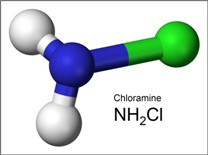
In the United States, Canada, and other first-world
countries, we are fortunate to have national and state regulations enacted to
protect our public water supplies. These
agencies, along with your local water provider, are tasked with delivering to the
public clean, disinfected water in order to prevent the spread of disease. The most common disinfectants used today are
chlorine and chloramine. While these
disinfectants are entirely necessary, even when used within federal regulation
guidelines, there still are serious health issues associated with routinely ingesting
such substances.
Chlorine is highly effective for the disinfection of water. However, challenges occur in the disinfection
process because chlorine can react with organic materials in the water,
especially from surface water sources. This
results in what is called “disinfection byproducts,” and these byproducts, such
as Trihalomethanes (TTHM), have been identified as #carcinogens and can lead to
serious illness.
Some water supply companies have made the switch from #chlorine
to chloramine. Chloramine (also referred
to as monochloramine) is a combination of chlorine and ammonia. While chloramine
is less likely to produce disinfection byproducts, it is a less effective
disinfectant than chlorine. It can also change
the chemical properties of water, which can foster corrosion and cause pipes to
leach lead and copper into the water.
Both chlorine and #chloramine are toxic to fish, aquatic
animals, reptiles, and amphibians. While
chlorine may dissipate from water if left to sit out for a few days, chloramine
cannot be removed in this manner.
Chloramine cannot be removed by either boiling or by the #distillation
process. In addition, chloramine vapors and disinfection byproducts can accumulate
in indoor air. The only effective way of
removing these disinfectants from your water is through point-of-use filtration
with a high quality carbon filter.
The Multipure family of water filtration systems reduces
chlorine and chloramine to the lowest possible levels, and these reductions are
tested and certified according to NSF/ANSI Standards. While many water filters on the market make
claims as to the reduction of disinfection chemicals and by-products, many are
not effective in reducing chloramine. You must insist on seeing #NSF testing and
certification of these claims. #Multipure
drinking water systems lead the industry in contaminant reduction, and this
includes the harsh chemicals used to disinfect your water.
|
 0 Comments 0 CommentsTweet |


